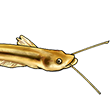Yuri Gomes Ponce De Carvalho Rocha, Telton Pedro Anselmo Ramos & Robson Tamar Da Costa Ramos. 2018. Phenacorhamdia cabocla, a new heptapterid from the Parnaíba River basin, Northeastern Brazil (Siluriformes: Heptapteridae). Zootaxa, Vol. 4402, No. 2: 353-362.
Abstract:
Phenacorhamdia Dahl, 1961 comprises 11 valid species of small demersal and solitary catfishes which occur mainly along riverbeds and are widely distributed throughout rivers of South America. The genus is included within the Nemuroglanis subclade, and species of Phenacorhamdia can be separated from other heptapterid catfishes through external and internal characters. Diagnostic characters include a prognathous mouth, first ray of dorsal and pectoral fins flexible, eight or nine branched rays in the lower lobe of caudal fin, and optic foramen reduced. A new species of Phenacorhamdia is described herein from the upper Parnaíba river basin. Phenacorhamdia cabocla sp. nov is distinct from its congeners by: total vertebrae 44, nine of which with pleural ribs; bifid neural spines until vertebrae 13; last precaudal vertebrae lacking pleural ribs; 7–8 branchiostegal rays; pectoral-fin rays i+6; first pterygiophore of dorsal-fin associated to the neural spine of twelfth vertebrae; dorsal-fin pterygiophores associated to vertebrae 12 to 16; anal-fin with nine branched and 3–4 unbranched rays; upper and lower lobes of caudal fin with 8–9 branched rays each; adipose fin corresponding to 14.9%–18.1% of standard length; and snout length corresponding to 30.0%–35.9% of head length.
http://www.mapress.com/j/zt/article/vie ... a.4402.2.7
Phenacorhamdia cabocla new species - Heptapteridae
-
lfinley58
- Expert
- Posts: 725
- Joined: 04 Jan 2003, 19:16
- I've donated: $90.00!
- My articles: 3
- My images: 3
- Spotted: 3
- Location 1: Margate
- Location 2: Florida USA
- Interests: Catfishes (all), Aquarium History




